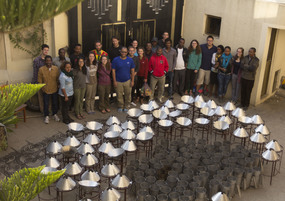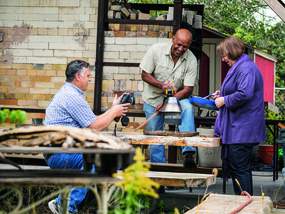It was while guiding the 2013 Carleton off-campus studies trip to Ethiopia that Professor Tsegaye Nega learned fuel efficient stoves were not being used by local communities. Although the stoves were designed to mitigate health problems and reduce environmental degradation, Nega observed that the emphasis on fuel efficiency came at the expense of two other important needs: fuel efficient stoves cost more than the average Ethiopian household could afford, and they were not equipped to cook injera, the sourdough flatbread that is the national dish of Ethiopia.
Yet, the burning of biomass, the traditional fuel source of Ethiopian communities, is known to cause massive health and environmental problems. Having an open fire in the kitchen with a traditional stove is equivalent to burning 400 cigarettes per hour. Estimates suggest that 50,000 Ethiopians die and another five million suffer from respiratory diseases annually. Deforestation, soil degradation, and air and water pollution are further impacts of a reliance on biomass fuel sources.
Nega returned to Carleton determined to design a stove that was more efficient while also meeting community needs. He began building stoves in his own garage, using tomato and paint cans. By trial and error he aimed to find the right model. Soon, this individual mission became a massive interdisciplinary collaboration, bringing together a diverse group of Carleton faculty, staff, and students.
In the summer of 2015, Randy Hoffner, a Science Support Specialist, and Nega built a prototype rocket and micro-gas fired stove. Deborah Gross, Professor of Chemistry, and her students created a literature review and tested the prototype. The next step was figuring out how the stoves could be produced in Ethiopia to make the endeavor more sustainable. Unfortunately, because he was unable to locate a working laser-cutting machine in Ethiopia, Nega realized that the stoves would have to be produced in the United States at a cost of $20,000.
The project soon became an interinstitutional collaboration: State Steel of Iowa offered to contribute to the project by donating the cut stoves. The Off-Campus Studies Office at Carleton paid for the cost of transporting the stoves to Ethiopia. With a collection of prototype stoves, Nega and his students headed to Ethiopia in the Winter 2016 term, prepared to study urbanization and the reconciliation of conservation and development.
Students conducted on-site research at two different condominiums. Residents at these sites cooked on traditional charcoal stoves in the stairwell, causing constant and collective exposure to the carbon monoxide. Because the stoves used charcoal, the production of each kilo requires 10 kilos of wood, thus further contributing to deforestation and environmental degradation.
Students introduced the new stoves while also providing fuel and community training on using the stoves. Students monitored community use of the stoves for five weeks, returning every three or four days to survey residents about their reactions to the new stoves. Because the stoves produced charcoal, which can be used as a soil conditioner, Nega and his students also built large raised gardens where residents dumped their charcoal, thus sequestering some carbon and mitigating climate change.
With these findings, Nega had a comprehensive review of the energy portfolio and he better understood how the new stoves functioned in a real-world situation. After returning from Ethiopia, he took a sabbatical from teaching in order to analyze the data collected. Nega found three problems with the stoves: their large size, the smoke they produced, and the size of the fire.
In collaboration with Tom Baraniak and Mark Zach from the physics department, Nega made the stove significantly smaller and added a fan that improved combustion and improved air quality. The fan is powered by a battery that can be charged either by a solar panel or wall outlet. In addition, the stove can be used to light a room or charge a cell phone. Nega also realized that if people could not make injera in the stove, the health and environmental problems of using solid fuels would persist since people would revert to old technology. So, Nega designed a simple add-on to the stove that makes it possible to bake injera. There was one more additional element that made the entire solution more efficient: rather than wood or c6harcoal as a fuel source, Nega created fuel efficient pellets, which have higher density, uniform size, and low moisture content.
During the summer of 2016, Deborah Gross and her students tested the new stoves for fuel efficiency and pollution. They compared the stove built by Nega and his collaborators to the Philips stove (the gold standard of similar stoves) and the traditional coal stove. This scientific experiment was conducted in a setting that mimicked real world conditions: a tent that simulated an Ethiopian kitchen and with a traditional Ethiopian lentil recipe. Preliminary results showed that Nega’s stoves were both more efficient and cleaner than the traditional Ethiopian stove, and even more efficient than the Philips stoves. Additionally, because Nega’s stoves have the ability to bake injera, charge cell phones, and function as a light, they are more likely to actually be adopted.
Nega hopes this interdisciplinary and interinstitutional effort will result, with continued efforts, in a widespread, popular, pollution-reducing, and sustainable program. Projects like his are a reminder of the impact that Carleton—with its industrious and creative faculty, staff, and students—can have in building sustainable change beyond the bounds of Carleton, of Northfield, and even of the United States.


